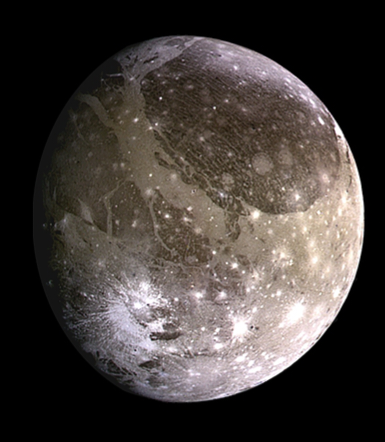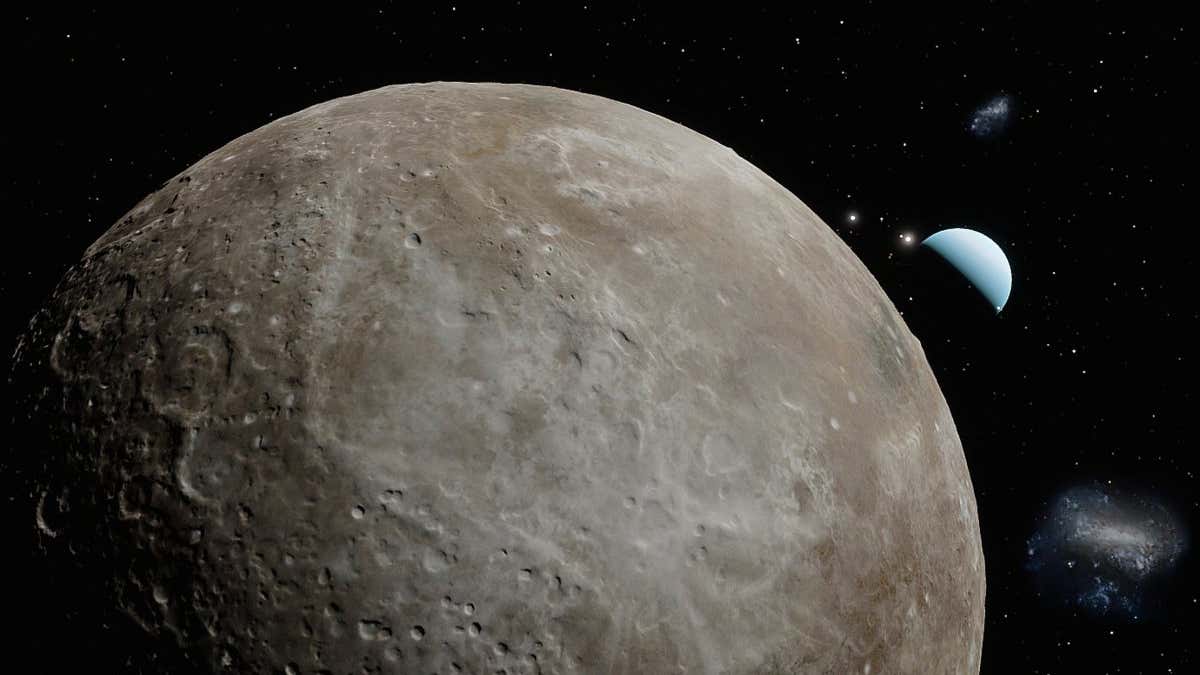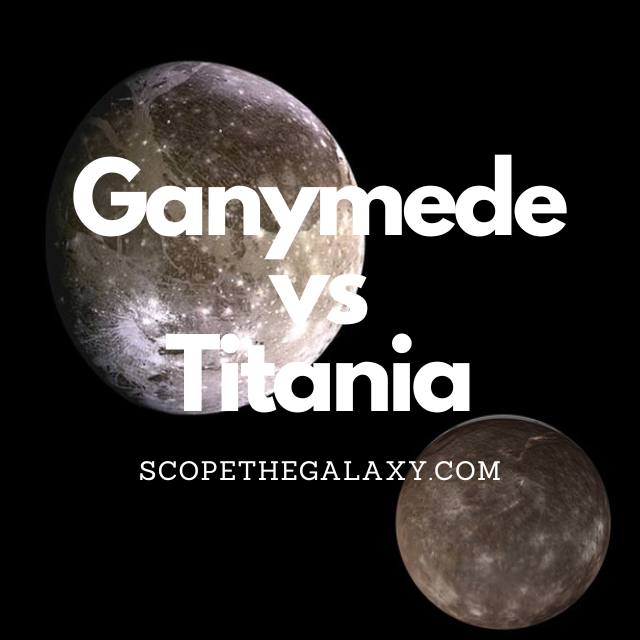*This post may contain affiliate links. This means we may make a commission if you purchase an item using one of our links*
The main differences between Ganymede and Titania are that Ganymede is the largest moon in our solar system while Titania is the 8th largest, Ganymede orbits Jupiter while Titania orbits Uranus, Ganymede has a magnetosphere while Titania doesn’t and Titania is believed to be composed of water ice while Ganymede is not.
There are various other differences between these two natural satellites so, continue reading if you want a more detailed look at each of these celestial bodies along with their similarities and differences below.
What Is The Moon Ganymede?
Table of Contents

Ganymede is the largest of the Galilean moons – and the largest moon in our entire solar system – first discovered on 7th January 1610. The surface of this icy world is frozen and covered by two main types of landscape: young, light regions and old, crater-filled terrain. And these darker areas seem to contain a number of organic materials.
Using the Hubble Space Telescope, astronomers have found evidence of an oxygen-based atmosphere. Still, it is far too thin to support any living organisms that we know of. Based on this, it’s unlikely that Ganymede hosts life as we know it.
Estimates place Ganymede at around 4.5 billion years old (the same age as its planet, Jupiter), and its average distance from the Sun is approximately 778 million km.
Its diameter is 5,268km, making it larger than the planet Mercury. Despite this, Ganymede only possesses half the mass of Mercury at 1.48 × 10^23kg, so it is still classified as a low-density object.
Ganymede takes seven days to orbit its planet at an average distance of 665,00km, and the temperature varies from minus 112 to minus 193 degrees Celsius. In regards to the moon’s core temperature, that would be around 1,226 – 1,446 degrees Celsius.
Among the fascinating features of this ice moon is its magnetosphere. While many planets possess a magnetosphere, no other moon in our solar system shares this trait.
Measuring the changes in the magnetic fields of Ganymede and Jupiter allowed scientists to predict that salt water lies beneath the surface of this freezing world.
However, this is insufficient to support life when you factor in the other elements of this giant moon. In contrast to Europa, the rocky layer of Ganymede is not directly below the ocean, so life would have a difficult time forming both above and below the ice.
In addition, the thick layer of ice on the moon’s surface would make internal, water-based life challenging for scientists to detect.
What Is The Moon Titania?

Titania is the biggest of Uranus’s moons, with a circumference of 4,956km and a diameter of 1576.8km.
The high density of this moon suggests that it most likely formed from a collection of dust and debris leftover from the formation of Uranus or from the debris created in the collision that reportedly tilted Uranus onto its side. As a result Titania has a mass of 3.4 × 10^21 kg.
First discovered on 11th January 1787 (the same day as the discovery of Oberon, the second biggest moon of Uranus) by British astronomer William Herschel, the name “Titania” comes from the Shakespeare play, A Midsummer Night’s Dream. (Most of Uranus’ moons are named after Shakespeare’s characters.)
Having observed Titania for many years, scientists theorize that its composition is likely to be equal parts ice and rock, the latter of which may contain carbonaceous materials and organic compounds.
Research suggests that the moon most likely has a rocky core (accounting for 66% of the moon’s radius) and an icy mantle. If the mantle contains ammonia, it will act as antifreeze and make it possible for liquid water to exist. In this instance, the moon could possess a layer of liquid ocean around 50km thick.
Titania tilts slightly towards the equator of Uranus and is tidally locked to its planet. This means a Titania day is 8 days and 17 hours which would be the same for its orbital cycle. Titania has an average temperature of -203 degrees Celsius.
The planet Uranus is also tilted, with the moons orbiting on the equatorial plane, giving it extreme seasons. On Titania, the north and south poles experience 42 years of complete sunshine followed by 42 years of total darkness.
Scientists have observed the presence of large amounts of carbon dioxide, suggesting this may be the primary component of this moon’s atmosphere. Thanks to the tilted orbit, and a concentration of solar radiation from the poles, Titania probably maintains a carbon dioxide cycle, similar to the hydrogen cycle on Earth.
Similarities Between Ganymede And Titania
As for the differences between the two, they include the below:
- Both have a hotter central core.
- Both have a rocky, terrestrial surface.
- Both are spherical in shape.
- Neither have rings surrounding them.
- Both are tidally locked to their planet.
- Both orbit their planet in an elliptical pattern.
- Neither have tectonic plate activity.
- Neither have other moons orbiting them.
Differences Between Ganymede And Titania
In regards to the differences between Titania and Ganymede, they include the below:
- Ganymede is larger with a diameter of 5,268km whereas Titania’s diameter is 1587.6km
- Ganymede has a very thin atmosphere composed of oxygen whilst Titania’s atmosphere is a very thin exosphere composed mostly of carbon dioxide.
- Ganymede has a magnetosphere whilst Titania does not.
- Titania orbits Uranus whilst Ganymede orbits Jupiter.
- Titania is 435,840km away from Saturn whilst Jupiter is 665,000km from Jupiter on average.
- Ganymede has an average temperature of -112 to -193 degrees Celsius whilst Titania’s average temperature is -203 degrees Celsius.
- In regards to gravitational strength, Ganymede’s is 1.428 m/s² whilst Titania’s gravity is 0.367 m/s².
- Titania has a density of 1.71 g/cm³ whilst Ganymede’s density is 1.94 g/cm³.
- In regards to mass, Ganymede’s is 1.48 × 10^23 kg whilst Titania has a mass of 3.4 × 10^21 kg.
- A Titan day along with its orbit around Saturn is 8 days and 17 hours whilst Ganymede completes a day and an orbit around around Jupiter in 7 days and 3 hours.
- It takes Ganymede 12 years to orbit the Sun whilst Titania completes an orbit in 84 years.
- Titan potentially has water ice beneath its surface while Ganymede does not.
Summary
Ganymede and Titania may both be amongst the 10 largest moons, are one of many natural satellites that orbit their respective gas giant planets and are also tidally locked to their planets but, they differ in numerous ways too.
Whether it be in regards to mass, size, their volcanic activity, gravitational strength, how dense each body is and more. Therefore, despite the fact both are spherical and rock based celestial bodies, they have many distinct features that easily distinguish the two from one another.

